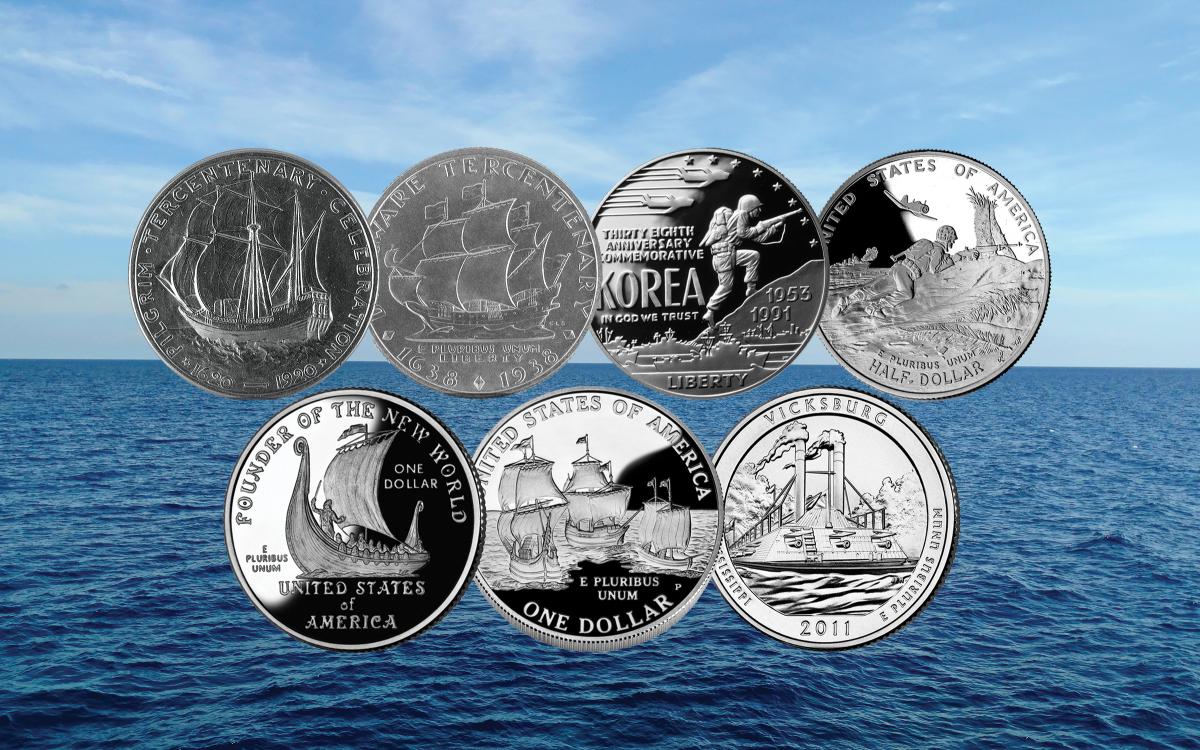As early as the 5th century BC, some ancient Greek and Phoenician cities decorated their coins with pictures of ships. The prow of a galley was such a common image on early bronze coinage of the Roman Republic that when Romans flipped coins they would say, Capita vel Navia? (“Heads or Ships?”) In medieval England, the rare gold “nobles” of rulers from Edward III to Richard III were adorned with an elaborate engraving of the king clad in armor standing in a ship.
Americans have always been a seafaring people, and U.S. coins reflect that history. The first “ship coins” were minted in 1892 and 1893, commemorative silver half dollars to celebrate the 400th anniversary of the voyage of Christopher Columbus. On the reverse is an imaginative rendering of the Santa Maria.
Coin collectors regard the 1920s and 1930s as the “Golden Age” of American commemorative coinage. A long series of silver half dollars were authorized, often as the pet projects of individual members of Congress. They were sold at a premium to raise money for various causes. For the 300th anniversary of the voyage of the Mayflower, the U.S. Mint in 1920–21 issued a commemorative half dollar.
A short-lived Swedish colony was established in Delaware in 1638. The ship Kalmar Nyckel (Key of Kalmar, named for a town in Sweden) brought the first colonists, who built Fort Christina, present-day Wilmington. The colony was taken over by the Dutch in 1655, and then by the English in 1664. Anticipating the 300th anniversary celebration, the U.S. Mint issued a commemorative half dollar in 1937, although the coin is dated 1936. (A replica of the Kalmar Nyckel, launched in 1997, is at Wilmington on the Delaware River as a museum ship.)
A few modern warships have even made an appearance on American coinage. An example is the Korean War commemorative silver dollar, issued for the 38th anniversary of the end of the conflict. Why 38? The 38th Parallel originally marked the boundary between North and South Korea, as shown on the coin’s reverse. The obverse depicts an infantryman climbing a hillside, with two F-86 Sabre jet fighters soaring above and some warships in silhouette below. There is a destroyer in the foreground, with a transport and possibly a cruiser behind.
Another modern Navy warship appears on the copper-nickel World War II 50th-anniversary half dollar issued in 1993 (but dated 1991–1995). The dramatic reverse is a Pacific island battle scene, with an infantryman firing over a sand berm, while a fighter flies overhead, a landing craft closes the beach, and a tiny warship fires from a distance. Proceeds from the sale of the coin helped to fund memorials in Normandy, France, and on the Mall in Washington, D.C. Sales totaled 197,072 coins, and examples currently bring about $15.
In 2000, to mark the 1,000th anniversary of Leif Erikson’s voyage from Iceland to North America, the U.S. Mint issued a commemorative silver dollar, the reverse of which depicts a Viking ship under way. The image appears to based on the 9th-century Gokstad ship preserved in Oslo, Norway.
For the 400th anniversary of the English settlement of Jamestown, Virginia, the U.S. Mint in 2007 issued a commemorative silver dollar. The reverse show three small ships sailing in close formation: the Susan Constant, Godspeed, and Discovery. A similar image of the three ships appears on the reverse of the Virginia state quarter issued in 2000.
The USS Cairo—named for the Illinois town at the confluence of the Mississippi and Ohio rivers—was constructed in 1861, the first of a class of seven shallow-draft ironclad river gunboats. Armed with 13 heavy guns of various calibers, the ship displaced 512 tons and had a crew of 250. On 12 December 1862, the Cairo was sunk by a Confederate mine in the Yazoo River. The wreck was raised from the muddy river bottom in pieces in 1964 and eventually reassembled as a museum display at the Vicksburg National Military Park, Mississippi. (See “Remembering Ed Bearss,” December 2020, p. 8.) A bow view of the Cairo under way also appears on the reverse of the 2011 “America the Beautiful” series quarter.
Most of the ships depicted on American coins have been full-rigged sailing ships. Modern vessels, and especially warships, have found little favor with Congress and the U.S. Mint, the authorities that determine what appears on coinage. Sailing ships are not just favorite historic subjects; when viewed in profile, they neatly fill the circular space of a coin. The long, low lines of modern ships leave blank space on a circular coin that designers like to avoid. So far, neither aircraft carriers nor submarines, the “capital ships” of a modern fleet, have found a place on American money. Quite a few modern ships have appeared on U.S. postage stamps—but that is a story for another issue.
—Michael Markowitz, research specialist, Center for Naval Analyses; contributing writer, CoinWeek.com



